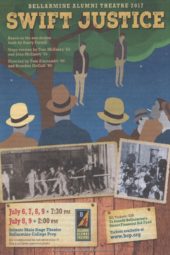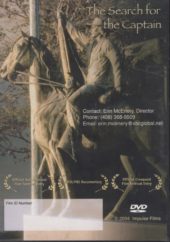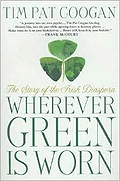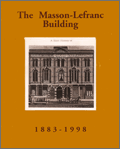Books & Plays
A collection of published works on city government, San Jose and Irish history.

A Statue for Ballybunion
Produced by Verdant Productions in Dublin, Ireland as “A Statue for Bill Clinton” at the O’Reilly Theatre.
Directed by Paul Meade and starring John Olohan.
Produced at the 3Below Theatre in San Jose – Spring 2020.
Directed by John McCluggage.
Based on the true events, mostly, of Bill Clinton’s visit to a small town in the west of Ireland in 1998. This happened in the midst of the Irish Peace Process, the Monica Lewinsky scandal and his possible Impeachment.

Swift Justice
Stage play written by Tom McEnery and performed at Sobrato Theater at Bellarmine in San Jose in 2017 and at the Tabard Theatre at San Pedro Square in 2016.
Based on the book by Harry Farrell on the true story of the kidnapping, murder and subsequent lynching in San Jose in 1933.

The Irish in the San Francisco Bay Area, Essays on Good Fortune
This book presents original essays on the distinctive experience of Irish American in the American West. It contains twenty essays and shorter contributions by many recognized scholars.
Excerpt:
In the front hallway of my home in San Jose, I have a trunk that measures four by five feet. Although it is empty, it carries the history of my family. In Ireland in 1898, a young woman in her early twenties packed all of her worldly possessions into that trunk and took a solitary, one-way voyage to a land of myth called California. Succeeding generations of her family would find many opportunities in the great place of hope. Yet her journey would never have begun if circumstances had been different; if only my grandmother – and the millions like her – had any reason to stay home and an opportunity to build a life in the land of her birth.
Ninety years after my grandmother left Ireland, I was returning from an international seminar in Italy and had the opportunity to stop in Ireland , where a seminal event was about to take place. In the sprawling county of Kildare, west of Dublin, Silicon Valley’s Intel Corporation, the world’s largest microchip maker, was having what the locals called a “sod turning”. This was to be its major European facility, and I had played a small part with the Industrial Development Authority of Ireland (IDA) in Intel’s decision to located in this Celtic outpost on the European fringe.

Search for the Captain
“How Can the Raising of the American Flag be Controversial in America?”
A documentary Directed and Narrated by Erin McEnery, Edited by Boris Zubov and written by Erin McEnery and Tom McEnery.
A look inside political correctness surrounding the unveiling of statue of Thomas Fallon in 2002 and the raising the American Flag in San Jose in 1846.
Selected for Cinequest Film Festival, San Francisco Film Festival and featured on PBS.

From the Ground Up: Building Silicon Valley
Introduction by Tom McEnery.

Wherever Green is Worn by Tim Pat Coogan
Excerpt:
The story of the Irish Diaspora, written by Ireland’s foremost historian, Tim Pat Coogan, and featuring a section on Tom McEnery’s involvement with Ireland in recent times. It explains his involvement with the Bytes to Belfast Program with Apple Computer in Northern Ireland. It also describes the tragic history of the McEnery family in Ireland’s struggle for independence in the Anglo-Irish War.
2001
Americans – excepting the relatively tiny percentage who hold the physical force tradition sacred – is how constructive its resonances can be, despite their frequently horrific background. For example. Tom McEnery’s grandfather, Patrick McEnery, was on the platform with Parnell when he delivered his famous ‘no man has a right to fix the boundary of the march of a nation’ speech. Archbishop Riordan and the Sinn Fein priest, Father Peter Yorke, were responsible for bringing Patrick to San Francisco, so that he could marry his childhood sweetheart, Catherine Costello, who had emigrated from their native Kerry in 1898. Amongst the letters preserved in the McEnery family are the following:
Dear Father Tom,
I will be going before my God in a few hours. Cheer up and console my wife and child and poor mother. Will you grant me one request and this is to look after Hannah’s welfare and bring up my darling son for the Church. It breaks my hear to think of my poor wife and child, but I depend on you to look after them, but for them I never would feel it, because I know I’m going to a better place – to my dear father and brothers who are in heaven. Say masses for my Soul and give money to Fr Ferris, he gave us confession and communion, so cheer up my dear brother. I gave my life as a Soldier of the Republic, but I never expected this would be my fate, but welcome the will of God.
Your son,
Jim
My Dear Mother,
I am going the long road tomorrow morning, to meet father and my brothers. Be good to Hannah and take care of Sonny – bring him up for the priesthood and don’t let anyone interfere with them. Don’t be downhearted; you can be proud of me. I am dying a Soldier of the Irish Republic. Goodbye now Mother darling, and we will all meet in Heaven.
Goodbye from your darling son,
Jim
The letters, which probably say as much about a Church-inculcated resignation and an emotion-suppressing culture as they do about the intrinsic tragedy involved, were written by Tom’s Uncle James. He was executed by the Free State authorities in 1923 after being captured with a group of IRA companions in Clashmealcolm Cave, high above a savage Kerry sea. Two of his companions were drowned before his eyes in a futile attempt to swim through smashing waves. The rest only surrendered, following days without food or water, when bales of burning hay were dropped into the cave mouth. The leader of the group, Aero Lyons, fell to his death as he was being hauled up the cliff when the rope either broke, or was severed.
However, growing up in California, Tom McEnery never heard a word of bitterness about the affair from his father, John Patrick McEnery. John Patrick became Superintendent of the Mint Under Truman, State Chairman of the Democratic Party and a successful businessman. One of his employees, who was particularly well loved by the McEnery household while Tom was growing up in San Jose, was an old Irishman called Mick McDonnell. The McEnerys never associated Mick with any revolutionary activity until on day in the 1950s – during which another IRA campaign had sputtered into life in Ireland – when the FBI came calling and suggested that Mick might be engaged in illegalities. They were politely shown the door. What the McEnerys didn’t know, until I told Tom nearly forty ears later, was that Mick was also the head of Michael Collin’s fearsome assassination team, ‘The Twelve Apostels’, which he set up to shoot spies and informers Collins had smuggled McDonnell out of Ireland for his own good during the War of Independence. Later, his brother was killed by James McEnery’s comrades during the Civil War. My father’s comrades shot James.
Curiously, although Tom McEnery never heard McDonnell speak of Collins, for some reason which he cannot fully explain, when Tom came to do his MA thesis he chose Michael Collins, not knowing that the Mick McDonnell whose activities he was researching for it was the kindly old Irishman of his boyhood, at whose funeral mass he had been an altar boy. However, when he first visited Ireland, he felt as though ‘a light switch had been thrown’. He only really began to research the details of his uncle’s death after a visit to a bar in Kerry in 1967, during which someone asked him, ‘Are you related to the McEnery that was killed in the caves? Someone else told him: ‘Your uncle was shot by the British.’ So far as the physical force tradition was concerned, there was no differentiation between the British and the Free State forces. The politics of the sixties were still influenced by the passions of the twenties.
Tom McEnery also went into politics and became the Mayor of San Jose. During his terms in office, the city grew to become the eleventh largest in the US. As it is the gateway to Silicon Valley, McEnery decided that it would be a good idea to twin San Jose with Dublin. However in the early 1980s, very few people in Irish Political circles had heard of Silicon Valley and his proposal fell on deaf ears. Then on day he phoned me from California. I brought the matter to the attention of Charles Haughey, the then Taoiseach who, whatever his other failings, had a capacity for quick decision-taking, and the cities were fully twinned, McEnery set up the Irish Industrial Development Authority in an Office in San Jose and introduced the IDA to the CEOs of some of the world’s top computer companies. Subsequently, whoever merits the credit, Intel, Seagate and Amdahl all locate in Ireland.
The twinning process has also meant that a great number of Irish public representatives and visiting fireman have fetched up in one of the Silicon Valley area’s more important websites on the information super-highway – Hannigan’s bar in Los Gatos. The difference between Hannigan’s and the electronic site is that once enmeshed in Hannigan’s web you’re trapped, a cyber liver is no use to you.

The Future Once Happened Here
A narrative written by Fred Seigel begins with Mayor Tom McEnery’s strange meeting with the National Conference of Mayors and the strange entrance of soon to be disgraced mayor, Marion Barry of Washington D.C.
Excerpt:
Former San Jose mayor Tom McEnery attended a meeting of the preeminent urban policy organization, the United States Conference of Mayors. The organization’s Washington headquarters is adorned with a large picture of President Franklin Roosevelt and with framed correspondence describing his close relationship with the mayors of the great cities:
Late in the day, “As yet another speaker droned on about the pressing need for increased federal assistance to cities,” says McEnery, the host, Mayor Marion Barry, finally showed up. Barry, dressed in the “red warm-up suit he must have slept in, slumped into the chair next to (McEnery) and closed his eyes”. McEnery goes on: “Suddenly, Marion Barry came alive, interrupting the speaker (to) blurt out a few non sequiturs.” Jaws dropped tot he sound of nervous laughter, and the conferees gazed in disbelief as Barry rambled on. Finally, he slumped back into his chair beside McEnery, apparently satisfied he had made his point. “Politely, we all acted as if nothing happened,” says McEnery. The speaker responded with, “Excellent point, Marion. now back on the subject of grants.” McEnery concludes, “I have never shuffled my papers as intently as i did the rest of the meeting.”

Men for Others: The Bellarmine Story : 150 Years of Tradition, Wisdom and Justice
Introduction by Tom McEnery ’63
There is something quite unique about the small Jesuit school in the College Park neighborhood of San Jose. If things had been different, this area would largely be remembered only as the place where Jack London’s hero and his dog, Buck, took a train north the Yukon in the opening pages of the Call in the wild. All of that changed in 1926, when a band of hearty priests and a few score students – my father among them – transferred a few short miles (but a massive relocation down the old pueblo-to-mission road) and ensconced themselves in the new campus of Santa Clara Prep; Bellarmine.
In the following text, we are reminded of all the things that are worthwhile and enduring about the old school at College Park. Boarders, commuters, day students – all were b0nded in a simple and complete way, by the time-honored methods: the kindly help of Brother Ryan, the jokes of Brother Huber, the scholarship of Fr. Flynn and Mr. Rewak, the firm counsel of the classics teacher turned disciplinarian, Fr. Joe Costa, and the role model of John Hanna. Not to be forgotten are the rhetorical triumph of Ed Romano and Jim Harville, the PE classes of the legendary baseball coach, Bob Fatjo, of that first class, and the courtliness and fond memory of Jerry Wade. I can never thank Mr. Lou Lucas enough for giving me a B, and just enough Spanish to win a few key precincts when I first ran for Mayor. We all remember the sheer terror of an encounter with Fr. Jim Rooney. All of these memories and so many others – the kidnapping of the young Brooke Hart and his murderers’ lynching by the citizens of San Jose, the deaths of “our boys”in World War II, the proposed routing of a highway through our campus and the pivotal fight over the International Airport – come alive again in these vivid stories.
We will hear once more, in the voices of our fellow students, those sounds of gratefulness for having learned so many lessons about life, friendship and love, in an environment where much was asked and much was given.
The beauty about the many gifts that were heaped upon us is the salient fact that we never realized we were on the receiving end of so much. Can we really consciously know that we are acquiring an absolutely transforming knowledge of why we help our fellow man, or volunteer to make our community or neighborhood or city a better place to live? To explain it is lose it. There, indeed, was more to the Spiritual Exercises of Ignatius than meets the eye or memory. Few of us can remember even one of them in detail, and yet most of us know why they are worthy of note. We must all recall that the young Ignatius was hit by cannonball before he saw the path of righteousness, we, on the other hand, only had Joe Costa’s grim stare. And I would only say this three decades later, but even Fr. Joe could scarcely fail to laugh when he had to rescind my brother John “jug” for dying his hair green on St Patrick’s Day, after he called my mother and discovered that her hair was also green for the day! But if a difficult memorizing of Shylock’s speech was not sufficient, we always had the classics. In what was, for many of us, a feeble attempt to acquire some knowledge of Latin or Greek, we received so much more. It is truly possible to find God’s mercy in even the most unnoticed places.
This fine new book my Dick Pfaff informs us in a text, as well as in primary voices, why this hallowed old high school holds such a special place in our hearts and our imaginations so many years later. We have in this recognition a shared beacon of learning and commitment. in such a mutual value system – which reinforced the lessons we first learned at our grandparents knees, or from our parents lectures and our siblings rebukes, each of us drew strength and a finer sense of purpose. It was obscured to us then; it is apparent to us now.
Bellarmine accomplished it’s mission, as as you read these pages, you will be reminded of it. No Ivy League or preparatory or Brahmin secondary school, Bellarmine was – and is – the ‘real deal’. the songs of Irish and iItalians immigrants, the flotsam and jetsam of Ellis Island, are joined in a continuum with Hispanic youth from the neighborhoods of East San Jose. The grandsons of fruit peddlers and cannery workers and publicans are forever linked in the Jesuit tradition of service with the children of field workers and immigrants and Asia and Mexico. There is a wonderful symmetry to it all, and the linchpin is Bellarmine’s time-honored and tested-by-fire creed of service to others. the connection is complete; the circle is closed.
Bellarmine has a firm place in the center of the most remarkable valley on the face of the earth, and it will always have a firm place in the hearts of the many it has touched, directly or indirectly. from pueblo to prunes to predecessors, here we became better people, and learned truths that will survive longer than a brief shining moment. there was a certainty developed at the old campus, that we could be much, much more than the sum of our parts. Love and service became the clarion calls, and in these noblest of virtues, we received a full measure of examples in the Jesuits, lay teachers and our fellow students.
Return now to a special place and enjoy the “remembrance of things past” and the assurance of more of the same in the future, for, in the tradition of Bellarmine, the historical continuum is always present and builds everyday on the hard work and sacrifice of those who preceded us. We can truly say that while much has been accomplished, the best is yet to come.

The Life and Times of Darryl Sutter: Wit, Wisdom, and Tougher Love
Written by E.C. McEnery and Edited by Tom McEnery
Once known as the “Harry Truman of hockey” (San Jose Mercury News) for his bluntness and humor, coach Darryl Sutter gave up the sport from 1995 to 1997 to care for his son Christopher, who was born with Down’s Syndrome. Brimming with anecdotes from on and off the ice, this book gives a close-up view of both sides of Sutter – the tough guy and the activist who started a foundation to raise money for nonprofit organizations.

The Masson-Lefranc Building
Written by Tom McEnery
The story of Paul Masson and the Lefranc Family and the founding of what would become the world famous California wine business. It concludes with the founding of San Pedro Square by Masson’s protege, John P. McEnery.
